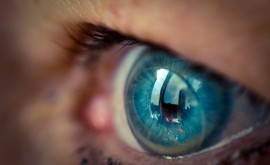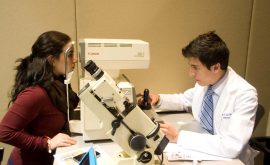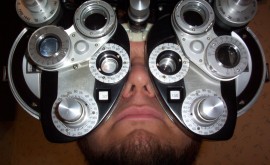I personally really enjoy assessing patients who have low vision. It is not always easy and at times it can be highly frustrating. There are many factors that influence the overall outcome. In my opinion, the patient’s mood and energy plays a big part. Patient ages vary within this field and an elderly patient who is motivated can be far more successful than a younger patient who is feeling dejected and irritable. Of course, it´s important to remember the cause of their low vision and whether it has occurred suddenly or gradually. Adapting to the patient needs and expectations is crucial here and also gauging how much a patient is capable of achieving within the consultation.
Low vision assessments are normally conducted within a hospital environment and so all the medical details and reasons for their sight loss is recorded already. However, I take note of the reason for their loss of sight, any general health issues and record all the medication they are on.
History and Symptoms
This is typically a very different set of questions to a standard eye test. Here we are playing close attention to their quality of life and whether or not their vision inhibits day to day activities. Even though patients may come for 6-12 monthly follow ups I would re ask similar questions as sometimes their circumstances can change quickly.
Questions include:
How do you feel your vision is at the moment? Do you struggle with one task more than another or is everything difficult in general?
Do you live alone?
Does the house have easy access if the vision is causing mobility problems? For example, does the house have steps up to the entrance and stairs inside?
What is the lighting like in the house? Does it cause glare or reduce vision even more?
Can you manage daily living tasks e.g. cooking, cleaning, shopping?
Do you have any help at the moment in terms of carers, cleaners or cooks?
Do you have family and friends close by?
Are the current spectacles up to date? (if they have any)
Have you tried magnifiers previously? If so, which are most useful. It is a good idea to bring their magnifiers with them for the appointment in order to check that the patient is using them correctly and that they are happy with them.
Measuring Visual Acuity (Aided or Unaided)
I use a LogMar chart here and it is also possible to use contrast sensitivity charts here for particular patients. For patients with less severe low vision, a Snellen chart may be used but LogMar gives a more accurate measurement of VA as a rule, due to each letter per line being used to calculate VA rather than only the line.
Retinoscopy or Autorefraction (if possible)
An up to date prescription is important and sometimes patients find it very difficult to do a subjective refraction due to a variety of reasons including age, mental ability or just such poor vision that it’s hard to determine whether anything is ‘better or worse’.
Subjective Refraction (where possible)
The type of subjective refraction needs to be adapted depending on the individual. Large steps must be used and try to avoid tiring out the patient too much. Encouragement is very important and boost their confidence by ensuring you finish the refraction with them reading a line or letter that they can comfortably see. In severe cases where they can only perceive light or count fingers – don’t waste time pushing them unnecessarily. Spend more time trying to find a suitable optical or non optical visual aid. Where applicable, eccentric fixation exercises can be given. Although sometimes successful, it is very tiresome for the patient.
Low Vision Optical or Non Optical Aids
If it has been possible to improve a patient’s vision with refraction or if the patient has a reading addition, I would primarily calculate the magnification they need for a particular task. For example, near vision can be calculated very easily. Firstly, measure the patient’s near visual acuity (VA) with their spectacles and then work out how much magnification they would need to see the desired size of print. E.g. the patient can see N16 with their current glasses. They would like to see N8 in order to read the paper comfortably. 16 divided by 8 is 2 therefore a 2 x magnification is required. I normally give slightly more than the exact calculation for example I would most likely try 2.5 x in the above example. Although, it is important to remember the higher the magnification, the smaller the field of view so try and avoid giving too much unless necessary.
It is true that we have a lot more aids for near vision tasks but for patients who struggle with distance there are options. For example, simply moving an object closer increases magnification. Also, the Max TV glasses have proven very popular for certain patients who wish to see the television screen more clearly.
Non optical aids are evolving all the time and all sorts of talking items are available including clocks, kettles, books, tin can labels etc.
Often it is a matter of trial and error when it comes to all aids and patients need to time to understand how to use them. Do not bombard a patient with loads of different aids at once. Make sure you only select a maximum of two or three and ensure the patient is able to use them comfortably prior to issuing.
Discussion of Certification of Visually Impaired and/or help from a Rehabilitation Officer
At the end of the consultation it is a good idea to make the patient aware of the possible help available. They may well already be registered as sight impaired but if not, explain whether they are eligible for registration and what potential benefits they’d be entitled to as a result. Also, discuss what a Rehabilitation Officer does and how they can help improve their quality of life by assessing their environment and offering support in a number of ways.
Conclusion
Patients with low vision can be a real challenge as sometimes unrealistic expectations can not be met. It is your responsibility to help them understand their condition and make the best of their remaining sight. Sufficient time and attention must be given to achieve the best possible result. Patients can be aggressive, irritable or generally distressed at losing their sight and managing to improve their quality of life by making a once loved task manageable, can be a very rewarding indeed.




